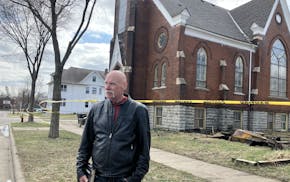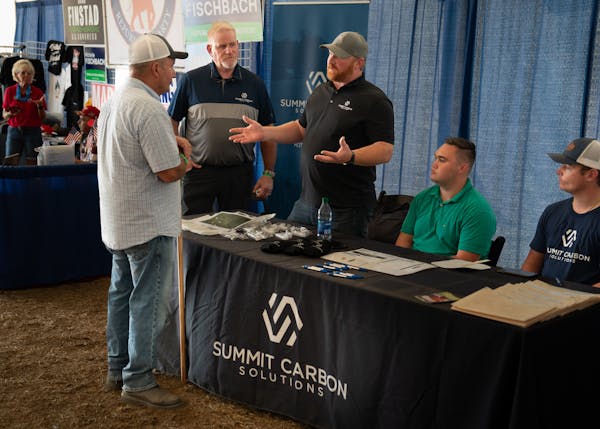FERGUS FALLS, MINN. – An entirely new kind of pipeline could soon be laid in Minnesota, and that worries Linda Schmidt, who lives along one potential path.
"If this would spring a leak, there is no way I get to safety in three minutes," Schmidt said last week during a public hearing in this western Minnesota city. "We've got our roots really deep here. We can't pick up and move."
Schmidt was one of dozens who came to a Fergus Falls event center where skeptics and supporters aired their views about a steel pipeline that would transport carbon dioxide from an ethanol plant across 28 rural miles to the North Dakota border.
That project is a tiny segment of a plan proposed by Summit Carbon Solutions, which hopes to build a sprawling, controversial 2,500-mile system for storing carbon that needs approval from five Upper Midwest states.
Summit has faced an erratic path to construction, including a major victory recently in Iowa but also setbacks in South Dakota. Critically, the company faces an uncertain future at its terminus in North Dakota.
The 28-mile Minnesota stretch represents a chance for Summit to claim another win. It will also serve as a test for how state regulators view the carbon-capture technology. Summit plans to apply later for permission to build a far longer stretch of pipeline in southwestern Minnesota linking six ethanol plants to its system.
In Fergus Falls, some raised concerns about the safety of the project and whether it actually helps the environment. Others sided with Summit, which says a pipeline can help the ethanol industry cash in as states push for lower-carbon transportation fuels.
"China has the largest grain reserves in the world, and it bought them from us," said Scott Lankow, a farmer who signed an easement with Summit. "What happens one day when they decide they don't need our crops for a while? We need to have a plan in place to keep us profitable."
Safety, environmental impact at issue
The hearing was one of several held by the Minnesota Public Utilities Commission (PUC) as it weighs a critical route permit for Summit.
Maps of the project crossing Wilkin and Otter Tail counties lined one side of the room in Fergus Falls. Officials, including an administrative law judge, sat up front.
At the hearing and in other public comments, input on the $67 million project has focused largely on two points of contention: whether the pipeline would be safe, and whether it would benefit the environment.
At Green Plains, Summit would capture carbon emissions from the ethanol plant and then compress, dehydrate and cool the gas so it can be transported through the pipeline at high pressure. Once delivered to western North Dakota, the gas would be injected underground for permanent storage.
Slashing carbon emissions helps ethanol producers earn premium prices in states like California, which require low-carbon fuels. Ethanol producers can qualify for federal tax credits for carbon storage and cleaner fuels. They are also hoping to open the Midwest market for lower-carbon ethanol-based aviation fuel.
"Markets are now forming that demand lower-carbon products, and the ethanol industry stands at the forefront of being able to attack those markets," said Summit CEO Lee Blank. "But they have to lower their carbon intensity score."
Glenn Peterson, an employee of the ethanol facility in Otter Tail County, said carbon capture would produce a cleaner ethanol. The continued operation of the plant would also boost the price farmers get paid per bushel of corn. "Living in a rural area that relies heavily on agriculture, the plant provides a substantial boost for farmers in the area," Peterson said.
In addition to the biofuels industry and landowners who have signed easements, several labor unions are supporting the project.
Others contend the system comes with risks.
CURE, an environmental nonprofit based in Montevideo, objected in Fergus Falls and in St. Paul, where Summit, state officials and others recently questioned expert witnesses about the project in a downtown hearing room.
The organization has a host of concerns, arguing for instance that Summit hasn't backed up its claim of capturing 100% of emissions from the plant's scrubber stack.
An environmental impact statement published in July by the Minnesota Department of Commerce said the pipeline would still benefit the climate if it captures even 40% of emissions. At 10%, the project would be a net polluter.
CURE — and other environmental groups, including the Sierra Club and the Minnesota Center for Environmental Advocacy — fear the carbon could be used in oil production, though Summit says it's contractually obligated to permanently sequester it.
More broadly, CURE is skeptical of a climate strategy that includes ethanol rather than alternatives such as electric vehicles, because of water pollution and other impacts from the intensive agriculture required for biofuels.
Project skeptics also note that a carbon pipeline rupture in 2020 in Mississippi sent 45 people to the hospital and required 200 people to evacuate. A rupture can be explosive, and carbon dioxide is toxic at high levels because it displaces oxygen.
In response to that disaster, federal regulators are strengthening pipeline safety rules, and CURE says companies pitching new pipelines should wait until that process is finished before moving ahead.
The state's environmental assessment notes the pipeline that ruptured in Mississippi was six times larger than what would be built in Minnesota. It also cited federal data of 66 carbon pipeline accidents, mostly leaks, between 2010 and 2021.
Blank said there are more than 5,300 miles of these pipelines in the United States., and no one has died from a carbon pipeline break since the technology started operating in the 1970s. Summit, which promises to exceed current pipeline standards, has plans for a system to monitor and respond to leaks with local officials. The company says it's following federal recommendations after the Mississippi failure and would have to follow any new rules.
A state contractor modeled a potential rupture, finding it could be life-threatening to people at a maximum of 617 feet away under a worst-case scenario, a distance of roughly two football fields. There are eight homes and one business within that distance of the likely route.
How Minnesota fits into Midwest debate
Summit won't build its Minnesota pipeline until the company gets permits elsewhere, particularly at the system's end in North Dakota.
That is not a sure thing. In August, North Dakota denied a siting permit for Summit but agreed to reconsider the move with a decision expected soon. In South Dakota, officials denied an application for the project last year, though Summit plans to reapply soon. In June, Summit notched a win when Iowa regulators approved the pipeline system there.
Summit's potential use of eminent domain is one reason for fierce opposition among some landowners and some conservative politicians elsewhere. That's not an issue in Minnesota, because Summit can't invoke eminent domain under state law, and the company has voluntary easements for 89% of its 28-mile segment, Blank said.
Still, Summit has drawn some complaints in years past for its treatment of landowners in southern Minnesota, and the debate in Fergus Falls could be a preview of more to come.
At the hearing, Peg Furshong, a CURE director, said the PUC should have considered both Minnesota pipeline spans, even though Summit has not applied for permits yet for its southern prong. The project there would run past the end of her driveway in rural Redwood County, and many in the audience had driven three hours north from the Lamberton region, Furshong said.
"What happens here in these 28 miles will happen to [residents] in southern Minnesota," Furshong said.

A Nashville scene in Shakopee? Entertainment district and amphitheater could reshape suburb.

Some Minnesota charter school leaders break rules to benefit themselves and avoid scrutiny

